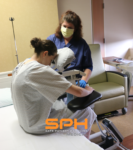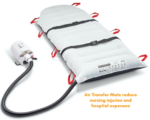Preventing Pressure Ulcers in Hospitals: The Vital Role of Stretcher Pads and Regular Pad Replacement
Pressure ulcers, commonly known as bedsores, pose a significant health risk in hospital settings. These sores can lead to severe complications, including infections and prolonged hospital stays, making their prevention an integral part of patient care. Pressure ulcers, also known as bedsores or decubitus ulcers, are injuries to the skin and underlying tissue that result from prolonged pressure on the skin. These wounds commonly develop on areas where the bones are close to the skin, such as the heels, ankles, hips, and tailbone. In this article we will be discussing the vital role of stretcher pads and regular pad replacement play in the prevention of pressure ulcers.
The impact of pressure ulcers extends beyond physical discomfort. They can lead to serious complications, such as infections and tissue damage, significantly affecting patient health and recovery. Furthermore, treating pressure ulcers requires additional medical resources, escalating healthcare costs.
Complications often develop with decubitus ulcers, with infection being the most common problem. Grade III and IV ulcers, in particular, require intensive management as their complications can be life-threatening. Infections can also spread from a pressure ulcer into underlying joints (septic arthritis) and bones (osteomyelitis). Both of these infections can damage the cartilage, tissue, and bone, and may also affect the joints and limbs.
If left untreated, pressure sores are extremely difficult to heal and may even lead to death. Certain risk factors increase the likelihood of pressure ulcer development, including immobility, debilitating illness, heart failure, chronic heart diseases, kidney disease, anemia, mental illness, Alzheimer’s disease, and even cleansing with soap and water.
Therefore, understanding pressure ulcers, their causes, effects, and potential complications, is paramount in healthcare settings. This knowledge forms the basis for effective prevention strategies, early intervention, and appropriate treatment, ultimately improving patient outcomes and reducing healthcare costs.
Prevention and Treatment of Pressure Ulcers
While treatments for pressure ulcers include dressings, creams, and sometimes surgery, prevention is the most effective strategy. Prevention strategies include regular repositioning, good nutrition and hydration, and using pressure-relieving devices like specialized mattresses and pads.
The Role of Stretcher Pads in Pressure Ulcer Prevention
This is where stretcher pads come into play. These pads are designed to distribute a patient’s weight more evenly, reducing the pressure on any one area of the body and thus lowering the risk of ulcer development. SPH Medical’s line of Geo-Mattress UltraMax stretcher pads are among the best in this regard. These pads feature a unique geometric design that maximizes body weight distribution and minimizes tissue interface pressures, making them an excellent choice for healthcare facilities.
Stretcher pads play an invaluable role in preventing pressure ulcers, particularly in settings like the emergency department where patients may endure long waits. These specialized pads work by effectively managing and distributing the pressure applied to patients, a crucial aspect of pressure ulcer prevention and treatment care protocols.
One of the key elements in stretcher pads that aid in pressure ulcer prevention is the use of specific materials such as foam. Foam surfaces are widely used with the aim of preventing pressure ulcers by providing a softer, more yielding surface that reduces the intensity of pressure on any one area of the skin.
Moreover, certain stretcher pads employ advanced technologies for added effectiveness. For instance, SPH Medical’s stretcher pads use a patented design in their 2″ mattress topper ensures superior protection from shear forces with shear minimizing bands beneath the heels, sacrum and scapula.
In surgical settings, the use of gel pads and other devices can help position patients to reduce the risk of pressure injury development during surgery. Similarly, in situations where a person slides down in bed or chair, causing blood vessels to stretch or bend, even slight rubbing or friction on the skin may cause pressure ulcers. Here, the right stretcher pad can make a significant difference.
Pressure-reducing devices, including stretcher pads, can lower tissue pressure to less than the capillary closing pressure, further aiding in preventing pressure ulcers. They can be applied to areas of the body vulnerable to pressure, friction, shear, and moisture, such as the sacrum and heels. By redistributing pressure, reducing friction and shear force to the skin, and managing humidity, these devices can help prevent pressure ulcers.
In conclusion, stretcher pads play a critical role in pressure ulcer prevention. Investing in high-quality stretcher pads equipped with advanced technologies can significantly contribute to patient comfort, recovery, and overall healthcare cost efficiency.
The Importance of Stretcher Pad Replacement and Maintenance
Just as crucial as having quality stretcher pads is maintaining them properly and replacing them when necessary. Over time, even the best stretcher pad can wear out and lose its effectiveness. Regular maintenance checks will ensure that your stretcher pads are always in top condition. When the time comes for replacement, choosing a reliable and proven product like the Geo-Mattress UltraMax can make a significant difference in pressure ulcer prevention.
Conclusion
In conclusion, pressure ulcers represent a substantial concern within healthcare settings. However, with the right understanding and preventive measures, they are largely avoidable. The key lies in comprehending the causes of these ulcers and investing in high-quality preventive tools, such as top-tier stretcher pads.
The financial implications of pressure ulcer prevention cannot be overstated. The direct costs associated with treating pressure ulcers can be significant, including prolonged hospital stays, additional nursing time, and the potential for surgical intervention. By contrast, investing in quality stretcher pads like the Geo-Mattress UltraMax and scheduling regular pad replacements is a cost-effective strategy that can significantly reduce these expenses.
Furthermore, reducing the incidence of pressure ulcers can also indirectly save costs by improving patient satisfaction and reducing the risk of readmissions, both of which can impact a facility’s bottom line. It can also enhance a healthcare facility’s reputation for providing high-quality, patient-centered care.
Therefore, making the right choice for your healthcare facility goes beyond just choosing quality and comfort. It’s about making a strategic decision that can improve patient outcomes, boost patient satisfaction, and result in significant cost savings. Choose wisely – choose the Geo-Mattress UltraMax for your stretcher pad or hospital bed replacement.


